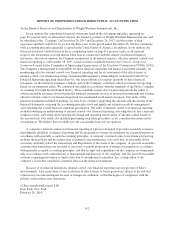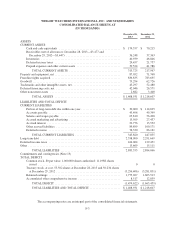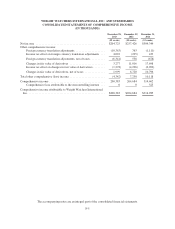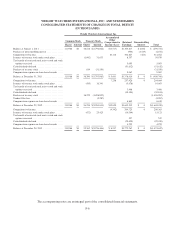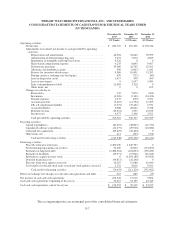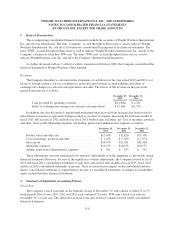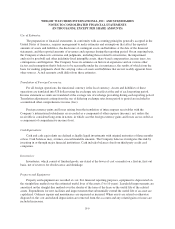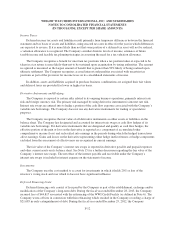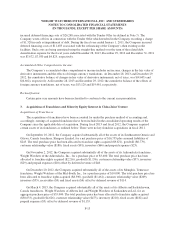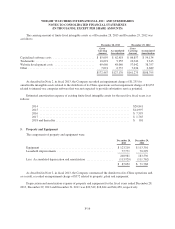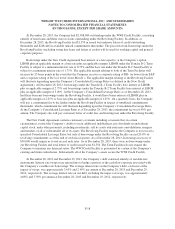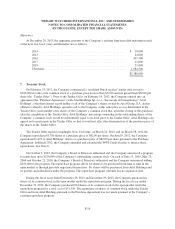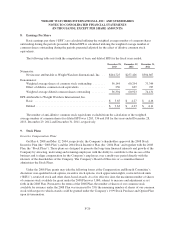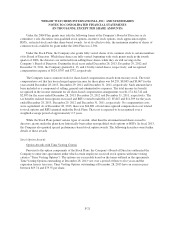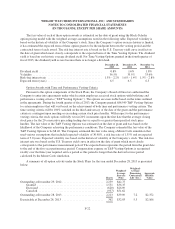WeightWatchers 2013 Annual Report Download - page 98
Download and view the complete annual report
Please find page 98 of the 2013 WeightWatchers annual report below. You can navigate through the pages in the report by either clicking on the pages listed below, or by using the keyword search tool below to find specific information within the annual report.WEIGHT WATCHERS INTERNATIONAL, INC. AND SUBSIDIARIES
NOTES TO CONSOLIDATED FINANCIAL STATEMENTS
(IN THOUSANDS, EXCEPT PER SHARE AMOUNTS)
Income Taxes:
Deferred income tax assets and liabilities result primarily from temporary differences between the financial
statement and tax bases of assets and liabilities, using enacted tax rates in effect for the year in which differences
are expected to reverse. If it is more likely than not that some portion of a deferred tax asset will not be realized,
a valuation allowance is recognized. The Company considers historic levels of income, estimates of future
taxable income and feasible tax planning strategies in assessing the need for a tax valuation allowance.
The Company recognizes a benefit for uncertain tax positions when a tax position taken or expected to be
taken in a tax return is more-likely-than-not to be sustained upon examination by taxing authorities. The amount
recognized is measured as the largest amount of benefit that is greater than 50% likely of being realized upon
ultimate settlement. The Company recognizes accrued interest and penalties associated with uncertain tax
positions as part of the provision for income taxes on its consolidated statements of income.
In addition, assets and liabilities acquired in purchase business combinations are assigned their fair values
and deferred taxes are provided for lower or higher tax bases.
Derivative Instruments and Hedging:
The Company is exposed to certain risks related to its ongoing business operations, primarily interest rate
risk and foreign currency risk. The primary risk managed by using derivative instruments is interest rate risk.
Interest rate swaps are entered into to hedge a portion of the cash flow exposure associated with the Company’s
variable-rate borrowings. The Company does not use any derivative instruments for trading or speculative
purposes.
The Company recognizes the fair value of all derivative instruments as either assets or liabilities on the
balance sheet. The Company has designated and accounted for interest rate swaps as cash flow hedges of its
variable-rate borrowings. For derivative instruments that are designated and qualify as cash flow hedges, the
effective portion of the gain or loss on the derivative is reported as a component of accumulated other
comprehensive income (loss) and reclassified into earnings in the periods during which the hedged transactions
affect earnings. Gains and losses on the derivative representing either hedge ineffectiveness or hedge components
excluded from the assessment of effectiveness are recognized in current earnings.
The fair value of the Company’s interest rate swaps is reported in derivative payable and prepaid expenses
and other current assets on its balance sheet. See Note 15 for a further discussion regarding the fair value of the
Company’s interest rate swaps. The net effect of the interest payable and receivable under the Company’s
interest rate swaps is included in interest expense on the statement of income.
Investments:
The Company uses the cost method to account for investments in which it holds 20% or less of the
investee’s voting stock and over which it does not have significant influence.
Deferred Financing Costs:
Deferred financing costs consist of fees paid by the Company as part of the establishment, exchange and/or
modification of the Company’s long-term debt. During the fiscal year ended December 28, 2013, the Company
incurred fees of $44,817 associated with the refinancing of the WWI Credit Facility (as defined in Note 6). The
Company wrote-off fees in connection with this refinancing which resulted in the Company recording a charge of
$21,685 in early extinguishment of debt. During the fiscal year ended December 29, 2012, the Company
F-12


